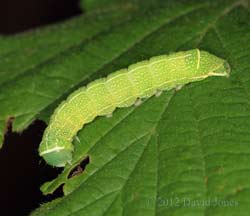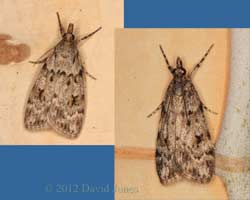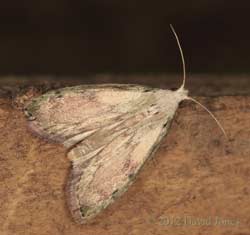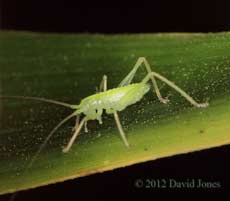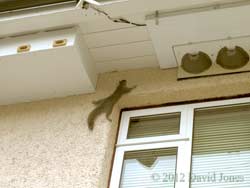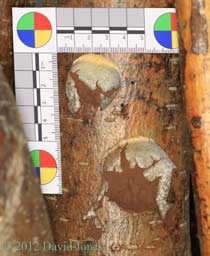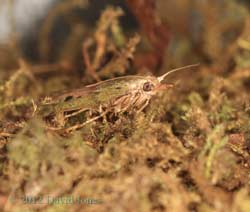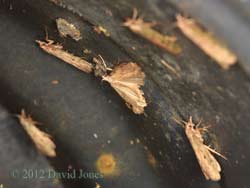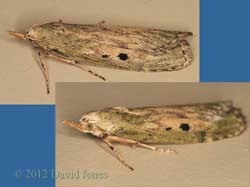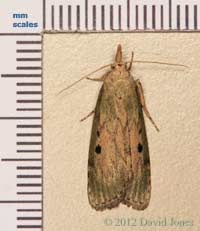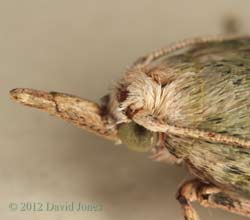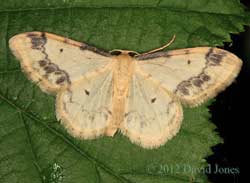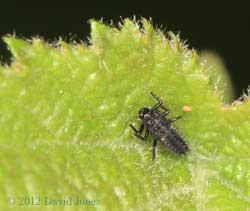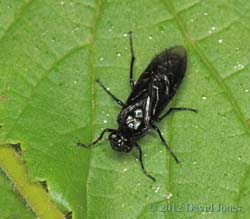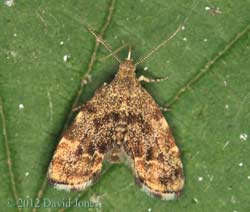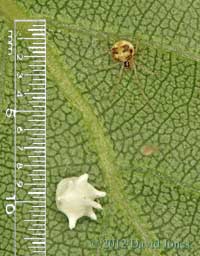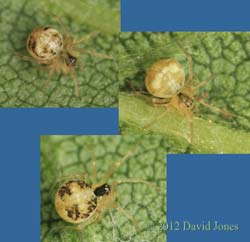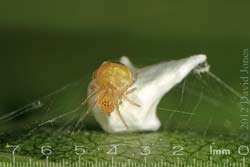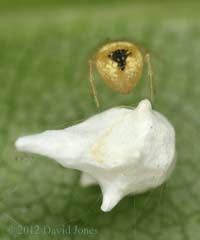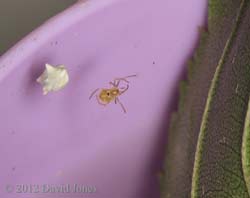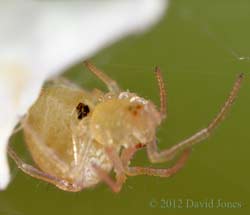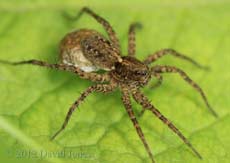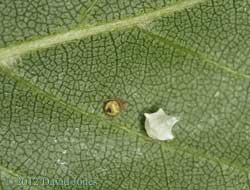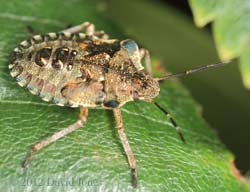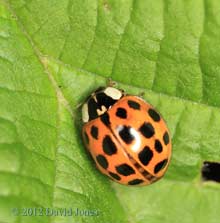Go to the final entry on this page .....Go to previous entry2 June - The Jubilee weekend has brought grey skies and cooler weather. Today the temperature didn't make it above 20C and although the day was dry, as I write this at 9pm this evening there is light rain falling outside. For us it has been a busy start to the month, with our grandson with us all day yesterday and then overnight. He and his mum and dad have now headed off to the north of England, so we won't be able to enjoy his (their) company for at least the nest week. Today is Sheila's birthday so it was party time with our grand-daughters (and their mum and dad) - this evening we are shattered! Anyway, all that meant that little time was spent in the garden, with just a few photographs taken (none today).
The first photograph was actually taken on 31 May, after I'd closed down the computers for the night, and shows a caterpillar on one of the Hazel saplings that we have. My best attempt so far at an identification suggests that it is the caterpillar of a Green Silver-lines moth, but I would need to take a closer look at the rear end to see if there is a red stripe on the claspers, and I haven't been able to find the caterpillar again.
Also that night, on the trunk of our Birch tree was the moth shown on the left of this pair of images. On the right, the second photograph was taken last night and shows what I think is another example of the same species, also on the Birch. Are they examples of the Pinion-streaked Snout? My moth guide says that their flight period starts from late June so it may be too early for that species.
A second moth species appeared last night, this time in the bumblebee nest. When I shone a torch into the nest's container there were at least a dozen of these moths in there, fluttering their wings vigorously, with a few more, including this individual, on the wood of the entrance. It would appear that they had just emerged from the moss of the nest. I don't know if it was caused by their activity, but there were several of the bumblebees moving around on the moss. I have not attempted to identify this species yet.
if the rain stops I'll check the Birch and the nest again tonight.
Last night I also found a bush cricket for the first time this year, on a honeydew covered bamboo leaf.
Yesterday afternoon there was a moment of excitement when Sheila called to me to say that "an animal has just climbed up our (aluminium) window frame"!
Anyway, just after this picture was taken it turned to face downwards and stayed almost motionless for ages, making a squirrel alarm call occasionally, before finally descending and disappearing again. It made no attempt to investigate any of the nests.
Back on 26 March I photographed these fruiting bodies on a log in our garden. At the time I assumed that they were produced by a species of fungus, although I was unable to get any further with an identification. However, thanks to Nick Aplin of the Sussex Fungi Group I now know that it was not a fungus but a Myxomycete (slime-mould) called Reticularia lycoperdon. I must find out more about slime-moulds.
3 June - A grey, generally damp day with early mist, drizzle and rain showers, although we didn't have the heavy rain that blighted the Jubilee festivities in London. The water butt collected no more than a couple of inches of water off the caravan shelter all day.
This evening it was dry enough to get out and check the bumblebee nest for moths again. I found one moth wandering over the nest itself,
and numerous others clinging to the roof of the nest box.
Last night I found another moth inside our house. It looks very similar to those in the previous two photographs, but at the moment I'm not so sure about it being the same species as the moth I photographed at the nest entrance.
This individual measures about 20mm in length. Having kept it since last night (released tonight) at no time have I seen it hold its wings in the manner of the moth at the entrance - also, that moth did not have the snout (made up of long palps) that this one possesses. However, it may be that when the moth has only just emerged the palps are not extended forwards?
The palps can be seen in this close-up that also shows its green eyes as well as some of the green scales that cover quite a lot of its wings.
I've identified both the moth in the house and those at the nest as Bumblebee Wax Moths (Aphomia sociella). This is interesting, but also potentially bad news for the Bumblebees. As its name suggests, this species has a close relationship with bumblebees (and social wasps). Its caterpillars live in their nests, eating nest materials, food stores and even the young bumblebee/wasp larvae themselves. They produce dense masses of silk webbing, tunnels and cocoons which can overwhelm the nest. An interesting account of the damage done by this species can be read here. The Wax Moth is an example of a micro-moth. This is an artificial classification based on size. Micromoths are usually described as moths having a wingspan of no more than 2cm, although this moth seems to exceed this. As it happens, identifying micro-moths will, I hope, become a little easier later this week when the postman should deliver a newly published Field Guide to the Micro-moths of Britain and Northern Ireland.
When I checked the bumblebee nest I spotted this Treble Brown Spot moth (Idaea trigeminata) resting on a Hazel leaf. It was about 1cm long, with a wingspan of just over 2cm.
4 June - Another grey morning with drizzle and a temperature of just 9C at 8.30am - what has happened to the summer we enjoyed just week? A high of just 13C was achieved during the afternoon - at least we enjoyed some blue skies in the evening.
13 June - Over a week since the previous entry, and today we experienced the first sunshine since that time! We had mainly blue skies for most of the day, and the temperature managed to reach a lofty 16C in the early afternoon before a couple of hours of cloud cover cooled things down again. We had a busy day, starting with me cleaning up the mess I made during my woodwork before taking a bit of time to take a few photographs before we had a visit from the youngest of our grand-daughters while her elder sister took a first look at the infants school that she will attend in the Autumn. Then it was off to help out with our grandson for a couple of hours!
There has been a sad lack of ladybirds in the garden so far this year, and today a search revealed no adults but several very small larvae on Hazel leaves. At the moment they measure no more than a couple of millimetres in length, and while I suspect that they are all Harlequin ladybirds I need to wait until they grow a bit more to confirm this.
This is one of our summer regulars, Rhadinocerea micans, a sawfly whose larva is dependent on Flag Iris plants, and which has probably been resident in the garden since 2005 when I first spotted one. Today I saw five adults, each on a different plant in the garden (but not the Flag Iris!).
I had the chance to press the shutter just once before this micro-moth detected my presence and made itself scarce. Looking back through the diary I see that I photographed what may be the same species back in May 2003, and it remained unidentified. I'm still waiting for the postman to deliver my new guide to micro-moths. Hopefully it will arrive soon so that I can identify them.....
The bumblebee nest is still active, although the mound of moss seems to have collapsed somewhat. Tonight I cannot see any sign of moth activity around the nest. Today's sunshine brought out not only insects but also spiders. By the side of the big pond I spotted several female wolf spiders carrying egg cases, although I couldn't get close enough to photograph one without disturbing them. I rescued a capsid bug that was floundering on the surface of rain water in a trug. I transferred the bug to the flower head of a grass growing nest to the pond only to find a couple of minutes later that it had become lunch for a crab spider!
While I do sometimes photograph spiders in the garden, I am guilty of ignoring them for much of the time, especially the small ones. However, occasionally they succeed in attracting my attention. On this occasion it wasn't the spider but its egg case that made the difference. Attached to the underside of a Birch leaf, this white case with points stood out, despite being just 3.5mm across at its widest. And nearby was the spider that had constructed this sculpture, a female Theridion pallens. This is a common species, and widespread in the UK. While I have only come across the egg case a few times in the garden, and only on the Birch tree, today I spotted two more on the opposite side of the Birch. Time and weather permitting I'll try to photograph the other example tomorrow to record any variation on body markings between the three spiders.
And to end today's entry I must return to the weather. We've had quite a bit of rain over the last week, although nowhere as much as many parts of the country. It means that both ponds are now full and so are the water butts. However, our mains water supply is dependent on aquifers and these are far from replenished, so our hosepipe ban is set to continue for a while yet.
14 June - After a bright start it became increasingly cloudy in the afternoon and wet by early evening. The temperature peaked at 16C and was 13C at 8pm. As proposed yesterday, at lunchtime I took some more photographs of the T. pallens spiders on the Birch tree. The individual first photographed yesterday is shown at the bottom of this trio, and all three were guarding pointed egg sacs. While the dark abdominal markings vary quite markedly, there appears to be a similarity in the form of a very light cross. Also, there is a dark, longitudinal band on the thorax/carapace which is particularly dark in two of them
This fourth spider is rather different in that it has a very dark patch towards the rear of its abdomen but no others, although the fact that it is guarding a characteristic egg case indicates that it is of the same species as the spiders shown above. In this photograph you can see how that case is secured using silk tethers - remember, the case is on the underside of the leaf.
This second view shows the rear facing dark patch.
Photographing these spiders in situ was problematic as a breeze caused the branches of the birch to sway. As I tried to record this last spider I was holding the leaf when the branch moved more than I expected, and the leaf stalk became detached. That gave me the opportunity to take the close-up pictures shown above and afterwards I stood the leaf with its stalk in a container of water while I considered if it would be possible to get the spider and egg case back onto the Birch.
This suggested that the spider would not abandon the egg case easily, so I took the container down to the bottom of the garden and gently transferred both spider and case to the rim of a healthy Birch leaf. This evening the case is back in a sheltered spot under the leaf with the spider in close proximity.
The activity in the container provided an opportunity to take a look at the underside of the spider, revealing a second dark area around the epigyne, the female's external reproductive structure. The structure of the epigyne is used in the identification of spiders, although in this case the image is not clear enough for that purpose.
Finally, a spider that was too elusive yesterday, a female Wolf Spider carrying her egg case on a plant next to the water of the big pond. A member of the genus Pardosa, but I'll need a much closer look to get a better ID.
15 June - Earlier in the week a weather forecast presenter cheerfully warned that we were in for another 'rinse cycle' today. It may well arrive later, but so far this morning (written at 9.20am) it has been a case of dry with sunny periods. There was some rain during the night but only just enough to leave around 5mm depth of water in the containers I've left out.
While the sun shone I went to check on yesterday's spider and I see that the egg case is now securely in place under a leaf, far from the edges, and with the spider very close by.
I may be mistaken but I believe that it is a Forest Bug (Pentatoma rufipes). If I'm correct then this is the first time I've identified this species in our garden. It isn't an adult but a last-instar nymph. If that is the case, I wonder how it got here.
Also 'sunbathing', but somewhat less welcome was this Harlequin Ladybird on a Hazel leaf. With what has been a bumper year so far for aphids and their relatives perhaps I should welcome any ladybirds, but I would far prefer to start spotting(!) our native species feasting on the aphids.
Click on images to see larger versions
|
|
